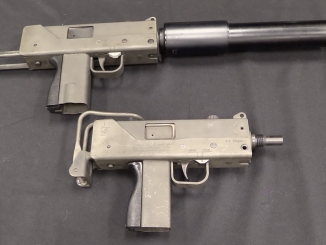Back before World War One, when Abercrombie & Fitch was still a true sporting goods company catering to the likes of Joseph Steinbeck and Theodore Roosevelt, they decided to offer Luger pistols for sale. This was simple enough, with guns ordered from DWM in Germany. It became harder after the war, however, when the Versailles Treaty strictly limited German arms production. So Abercrombie found a workaround by ordering 100 pistols through Hämmerli-Walther in Switzerland, who bought incomplete guns and installed their own barrels and did their own finishing. These guns (50 in .30 Luger and 50 in 9x19mm) arrived with the barrels marked with A&F’s name, and they are a particularly desirable variation of Luger for collectors.
So, today Brad Simpson from Simpson Ltd is going to walk us through how to authenticate a true Abercrombie Luger. We will look at the serial number, the finish, the front sight, and the frame reinforcing on the inside.



Interesting variation on the Parabellum pistol.
One additional characteristic to look for should be swiss proof marks instead of german ones, beause the pistols were completed in Switzerland and not Germany.
Very cool version of the Luger, thanks for sharing!!! I would have liked to see the inside of the store in those days. I am certain that the original Mr. Abercrombie and Mr. Fitch would be rolling in the grave to see the silly clothing, anti-gun, all PC and anti-freedom company their names are on today.
“Anti freedom”……..get a grip.
Our apologies. Can we just say that companies change with social climate?
Agreed. Not sure if I should even discuss social issues here again after my last failure, but I have to warn you that American society has almost halfway fallen to anti-intellectual mobs of both extreme left and extreme right wings. Believe me, just look up “social justice warrior” and you will know what I mean. Please don’t throw rocks at me…
You be your own censor. Speak up 🙂
The current “Abercrombie and Fitch” clothing company shares only it’s name with the original. I visited the Abercrombie and Fitch store in New York City once as a child in the 70s shortly before they closed down and there was still an extensive hunting and fishing section. The attempted revival in the early 80s was more lifestyle oriented like LL Bean or Orvis, and when that failed the name landed on a fungible shopping mall clothing brand whose antics have messrs A & F spinning in their graves. Back on topic, high private label guns like A&F or Stoeger are an interesting specialty compared to mass marketers like Sears and Wards
“(…)harder after the war, however, when the Versailles Treaty strictly limited German arms production(…)”
I am wondering how said war affected demand for German automatic pistol, taking in account anti-German sentiment present during it, which lead for example to Sauerkraut becoming liberty cabbage: https://de.wiktionary.org/wiki/liberty_cabbage
Did such sentiment vanished after end of war or sales were considerable lower?
When I, more that 30 years after WWII end arrived to Canada, the anti-German sentiment was still present. I could speak of concrete experiences, but defer to personal study for those who are interested.
Non-related, but very interesting: just watched Mr. Kasarda’s video describing tragic events in POW camp in Utah where German and Italian servicemen were stationed during and after WWII.
https://www.youtube.com/watch?v=Hadr54qHMxE
I wish A&F’s records were still around. I know of a Registered Magnum that letters to them and was supposed to have been Hemingway’s.
1) Speaking as someone who worked in corporate finance at one of the Fortune Ten after retiring from the Army and was involved in records management as a part of my job, I doubt A&F would have any but the most vital records(primarily legal and financial – things that would interest the IRS) prior to 2010. The policy of the firm I worked for was current year plus two back on site, years four to seven off site (in a warehouse at a vendor like Iron Mountain) and then destroy. This seems to be the standard practice in industry.Reason? It costs money for storage space and management. It’s a miracle that people like Colt and S&W have held onto sales records dating back to the neolithic era.
2) Why would any American want a Luger when you had the civilian version of the M1911 available for sale?
I know this is a late reply, but came across this quote from the November 1967 issue of Mechanix Illustrated on A&F:
“Today A&F is a large department store with some sporting departments…I remember many years ago when they had a kennel on the roof and specialized in all sorts of hunting dogs. Airedales for bear hunting in the Rockies, Beagles for rabbits, and they even had some artificial cover and quail for demonstrating Pointers and Setters. In every department they had known experts to advise on the correct fishing tackle needed for trout or marlin, and in the gun department you’d met men equally well versed in everything from tiger shooting to pheasant drives. Like everything else, it has changed.” -Tom McCahill
I had one of those Abercombie & Fitch Lugers in the 60s & 70s. True to the problem with all lugers, of all of the times I practiced with the gun, only once was I able to fire the entire clip + a round in the chamber without it jamming. Not knowing it was an antique already, I sold it to a gun shop.